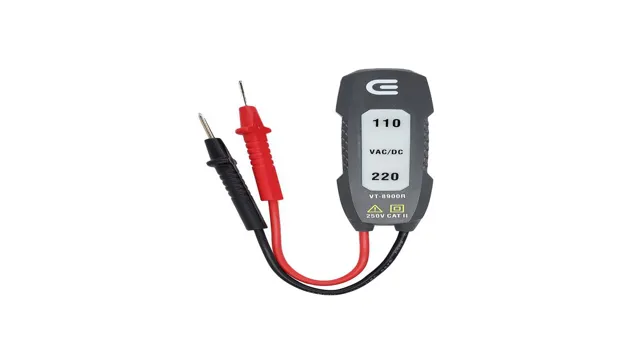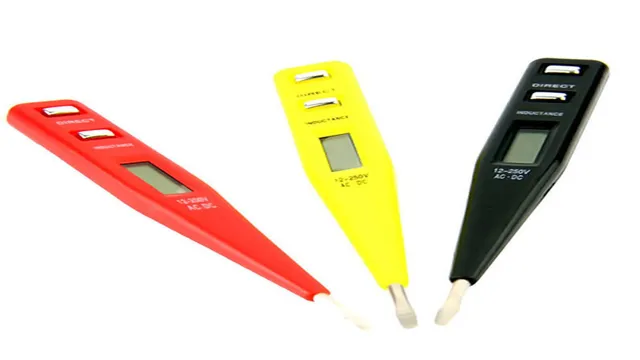Welcome to our comprehensive guide on how to use an AC/DC voltage tester! If you have any experience with electrical work, you know how important it is to have the right tools. When it comes to voltage testing, an AC/DC voltage tester is a must-have tool for any electrician or DIY enthusiast. It allows you to test the voltage of electrical circuits quickly and accurately, which is crucial for ensuring your safety and preventing damage to electrical systems and appliances.
In this guide, we will cover everything you need to know about using an AC/DC voltage tester, including what it is, how it works, and how to use it safely and effectively. We will also provide you with tips and tricks for troubleshooting common voltage testing problems and ensuring that your tester is working correctly. Whether you’re a seasoned electrician or just getting started with DIY electrical work, this guide is for you! Our goal is to equip you with the knowledge and skills you need to use an AC/DC voltage tester with confidence and precision.
So let’s dive in and get started on your journey towards becoming a voltage testing expert!
What is an AC/DC Voltage Tester?
If you’re working with electrical circuits or wiring, it’s important to use an AC/DC voltage tester to ensure your safety and accuracy. This tool measures the amount of voltage present in an electrical current, allowing you to determine if it’s safe to work with or not. To use your AC/DC voltage tester, you’ll first need to turn off the power source you plan to test.
Next, bring the tip of the tester close to the source or outlet you want to measure. If the tester lights up or beeps, that means it’s detecting a voltage present. You can then use the display on the tester to determine the exact amount of voltage present.
It’s important to note that this tool is best used by trained professionals, so if you’re unsure about how to use it or are working on a complex project, it’s best to seek out someone with more experience. Overall, an AC/DC voltage tester is a crucial tool for anyone working with electrical currents, as it helps keep you safe and ensures the accuracy of your work.
Understanding the Basics
An AC/DC voltage tester is an essential tool for electricians and DIY enthusiasts. It’s a device that tests the presence or absence of voltage in electrical outlets, wires, and circuits, and helps ensure that they’re safe to use. The tester features two probes, which are connected to a handle or control unit.
You insert the probes into electrical sockets, wires, or other electrical components, and the tester will indicate the presence or absence of electricity. It’s important to choose the right tester for the job you need to do, as they come in various shapes and sizes for different types of testing. Overall, an AC/DC voltage tester is a basic tool that is useful for anyone who deals with electricity, and it’s highly recommended that you invest in one to help keep you safe when working with electrical components.

Types of AC/DC Voltage Testers
An AC/DC voltage tester is a handheld tool used to detect the presence of voltage in electrical outlets, wires, cables, and circuits. It alerts the user if there’s any voltage or current flowing through the conductor. There are various types of AC/DC voltage testers available in the market, each having its own unique features and functions.
Some of the popular types include non-contact voltage testers, digital multimeters, analog multimeters, clamp meters, and circuit tracers. Non-contact voltage testers use a sensor to detect the voltage without touching the conductor. They are simple to use and are usually affordable.
Digital multimeters display the voltage, current, and resistance digitally on an LCD. They are versatile and can perform various tests. Analog multimeters have a pointer that moves along a scale to indicate the readings.
Clamp meters are used to measure the current flowing through a conductor. Circuit tracers are used to locate the path of a wire or cable inside the walls. Choosing the right type of voltage tester depends on the task at hand and user’s experience.
It’s important to use a tester that is appropriate for the type of work and always follow the safety precautions necessary.
How to Use an AC/DC Voltage Tester
Using an AC/DC voltage tester might seem daunting, but with a few simple steps, you can test electrical outlets, switches, and devices safely. First, make sure the voltage tester is calibrated correctly according to the included instructions. Always check the voltage on a known power source before using the tester.
To use the tester, insert the leads into the outlet or touch the wires of the device being tested, making sure there is no exposed metal or electrical current present. The tester will indicate the presence and strength of an electrical current through the display or a sound alert. It’s essential to follow safety precautions when using voltage testers, such as wearing protective gear and keeping pets and children away from the testing area.
By using an AC/DC voltage tester correctly, you can safely determine if an electrical circuit is live and potentially prevent accidents or damage to electronics.
Precautions to Take
When using an AC/DC voltage tester, there are a few precautions you should take to ensure your safety. First and foremost, make sure you read and understand the instructions provided with the tester before use. It’s essential to wear protective gear, such as gloves and goggles, when working with electrical equipment.
Before testing, double-check that the device is turned off and unplugged to avoid electrocution. Always test the voltage of the tester on a known voltage source before using it on any unknown circuits. Avoid touching the metal tips of the tester with your bare hands, and be sure to keep it away from any moisture or conductive surfaces.
By following these precautions, you can use an AC/DC voltage tester with confidence and avoid any potential hazards.
Step-by-Step Guide
If you’re thinking of doing some electrical work around your home, one of the first things you’ll want to do is to make sure that the power is turned off to the device or outlet you plan to work on. That’s where an AC/DC voltage tester comes in handy. It’s a great tool that can give you a quick reading of the voltage flowing through a wire or outlet.
Using an AC/DC voltage tester is pretty straightforward. Start by inserting the tester’s probes into the outlet or wiring you want to check. The device will then display the voltage level.
It’s worth noting that an AC/DC voltage tester is a great tool for checking circuit breakers, outlets, and switches before you start any electrical work. By using this tool, you can avoid any accidents or electrocution while working on electrical projects. So, make sure to add it to your toolbox and keep it handy whenever you plan on doing any electrical work around your home.
Interpreting the Results
Using an AC/DC voltage tester might seem daunting, but it’s actually quite simple and essential for anyone dealing with electrical wiring. To start, you’ll need to turn the tester on and select the appropriate voltage range for your current task. You can do this by rotating the selector switch on the device.
Once the range is set, proceed to touch the probe tips of the device to the wires or terminals of the circuit you’re testing. If the current is present, the tester will light up and emit a beeping sound or a vibration. Make sure to keep the probes away from metal objects or other exposed wiring, as this can cause false readings.
Remember to always turn off the power source before testing any electrical circuit or wiring! By using an AC/DC voltage tester, you can ensure the safety of yourself and those around you while working with electrical systems.
Troubleshooting Tips
If you’re not familiar with how to use an AC DC voltage tester, it can seem intimidating at first. However, with a little bit of guidance, it’s actually quite easy to use. First, make sure to read the instruction manual carefully, as different voltage testers can have slightly different features and methods of operation.
Next, ensure that the device is properly calibrated before use. To do this, simply hold the two probes together and adjust the calibration knob until the meter reads zero. Once calibrated, you can use the tester to check the voltage of a circuit by placing one probe on a hot wire and the other on a neutral or ground wire.
Always use caution and follow safety guidelines, such as wearing protective gear and turning off power to the circuit before testing. With a little practice, you’ll become comfortable using an AC DC voltage tester in no time!
Common Issues and How to Fix Them
As technology advances, it’s not uncommon to experience issues with our devices. The good news is most problems have simple solutions. If you find yourself encountering an issue, the first step is to do a quick search online to see if others have experienced the same problem and how they fixed it.
Updating software and drivers is often the solution to problems with devices not functioning correctly or connecting properly. If you’re experiencing issues with slow internet, try resetting your modem or router, or contacting your internet service provider. Many problems with battery life can be resolved by adjusting your device’s settings, such as turning off automatic updates or reducing screen brightness.
If you’re experiencing hardware issues such as a broken screen, it’s best to take your device to a professional for repair. Remember, it’s always best to try troubleshooting before replacing a device entirely.
Conclusion
In conclusion, using an AC/DC voltage tester is all about safety, accuracy, and some good old-fashioned common sense. Make sure you read the instructions and understand the basics of electricity. Double-check your tester before each use and always wear protective gear.
And remember, if you’re not sure what you’re doing, don’t hesitate to call a professional. Using an AC/DC voltage tester is a powerful tool, but with great power comes great responsibility. So go out there and use it wisely, because as Benjamin Franklin once said, “An ounce of prevention is worth a pound of cure.
” Happy testing!”
FAQs
What is an AC/DC voltage tester?
An AC/DC voltage tester is an electrical testing tool that measures the voltage of alternating current (AC) and direct current (DC) circuits.
How do I use an AC/DC voltage tester?
To use an AC/DC voltage tester, first ensure it is calibrated correctly and choose the appropriate setting for your circuit (AC or DC). Then, place the tester’s leads on the circuit’s terminals or wires and read the voltage displayed on the tester.
Is it safe to use an AC/DC voltage tester?
Yes, but only if proper safety precautions are taken, such as wearing protective gloves and eyewear, shutting off power to the circuit before testing, and following the manufacturer’s instructions carefully.
How accurate are AC/DC voltage testers?
The accuracy of an AC/DC voltage tester depends on its quality and calibration. Lower quality testers may have more significant inaccuracies, while higher-end models will provide more precise readings.
What should I look for when purchasing an AC/DC voltage tester?
When purchasing an AC/DC voltage tester, consider its accuracy, durability, ease of use, and compatibility with the types of circuits you will be working with.
Can an AC/DC voltage tester be used to test other electrical components besides voltage?
No, an AC/DC voltage tester is designed specifically to test only voltage and should not be used to test any other electrical component.
How often should I calibrate my AC/DC voltage tester?
It’s recommended to calibrate your AC/DC voltage tester at least once a year or according to the manufacturer’s instructions to ensure its accuracy.






